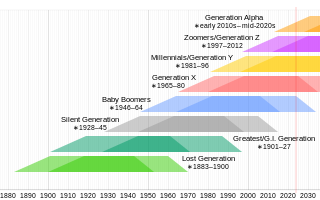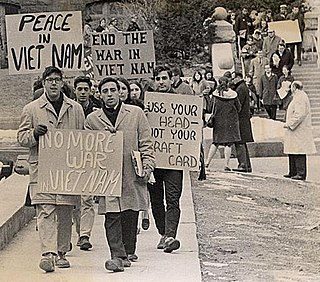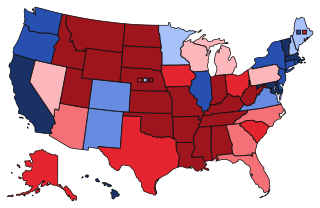Related Research Articles
A political spectrum is a system to characterize and classify different political positions in relation to one another. These positions sit upon one or more geometric axes that represent independent political dimensions. The expressions political compass and political map are used to refer to the political spectrum as well, especially to popular two-dimensional models of it.
Theories of political behavior, as an aspect of political science, attempt to quantify and explain the influences that define a person's political views, ideology, and levels of political participation. Political behavior is the subset of human behavior that involves politics and power. Theorists who have had an influence on this field include Karl Deutsch and Theodor Adorno.

Baby boomers, often shortened to boomers, are the demographic cohort preceded by the Silent Generation and followed by Generation X. The generation is often defined as people born from 1946 to 1964 during the mid-20th century baby boom. The dates, the demographic context, and the cultural identifiers may vary by country. Most baby boomers are the children of either the Greatest Generation or the Silent Generation, and are often parents of Millennials.
The New Deal coalition was an American political coalition that supported the Democratic Party beginning in 1932. The coalition is named after President Franklin D. Roosevelt's New Deal programs, and the follow-up Democratic presidents. It was composed of voting blocs who supported them. The coalition included labor unions, blue-collar workers, big city machines, racial and religious minorities, white Southerners, and intellectuals. Besides voters the coalition included powerful interest groups: Democratic Party organizations in most states, city machines, labor unions, some third parties, universities, and foundations. It was largely opposed by the Republican Party, the business community, and rich Protestants. In creating his coalition, Roosevelt was at first eager to include liberal Republicans and some radical third parties, even if it meant downplaying the "Democratic" name. By the 1940s, the Republican and third-party allies had mostly been defeated. In 1948, the Democratic Party stood alone and survived the splits that created two splinter parties.

A generation is all of the people born and living at about the same time, regarded collectively. It also is "the average period, generally considered to be about 20–30 years, during which children are born and grow up, become adults, and begin to have children." In kinship, generation is a structural term, designating the parent–child relationship. In biology, generation also means biogenesis, reproduction, and procreation.

Youth culture refers to the societal norms of children, adolescents, and young adults. Specifically, it comprises the processes and symbolic systems that are shared by the youth and are distinct from those of adults in the community.
In medicine and the social sciences, a young adult is generally a person in the years following adolescence, sometimes with some overlap. Definitions and opinions on what qualifies as a young adult vary, with works such as Erik Erikson's stages of human development significantly influencing the definition of the term; generally, the term is often used to refer to adults in approximately the age range of 18 to 40 years, with some more inclusive definitions extending the definition into the early to mid 40s. The young adult stage in human development precedes middle adulthood.
In social psychology, group polarization refers to the tendency for a group to make decisions that are more extreme than the initial inclination of its members. These more extreme decisions are towards greater risk if individuals' initial tendencies are to be risky and towards greater caution if individuals' initial tendencies are to be cautious. The phenomenon also holds that a group's attitude toward a situation may change in the sense that the individuals' initial attitudes have strengthened and intensified after group discussion, a phenomenon known as attitude polarization.

Political party strength in U.S. states is the level of representation of the various political parties in the United States in each statewide elective office providing legislators to the state and to the U.S. Congress and electing the executives at the state and national level.
Political psychology is an interdisciplinary academic field, dedicated to understanding politics, politicians and political behavior from a psychological perspective, and psychological processes using socio-political perspectives. The relationship between politics and psychology is considered bidirectional, with psychology being used as a lens for understanding politics and politics being used as a lens for understanding psychology. As an interdisciplinary field, political psychology borrows from a wide range of disciplines, including: anthropology, economics, history, international relations, journalism, media, philosophy, political science, psychology, and sociology.
An independent voter, often also called an unaffiliated voter or non-affiliated voter in the United States, is a voter who does not align themselves with a political party. An independent is variously defined as a voter who votes for candidates on issues rather than on the basis of a political ideology or partisanship; a voter who does not have long-standing loyalty to, or identification with, a political party; a voter who does not usually vote for the same political party from election to election; or a voter who self-describes as an independent.
Selective exposure is a theory within the practice of psychology, often used in media and communication research, that historically refers to individuals' tendency to favor information which reinforces their pre-existing views while avoiding contradictory information. Selective exposure has also been known and defined as "congeniality bias" or "confirmation bias" in various texts throughout the years.
"Religious development" refers to the formation of religious beliefs and values in individuals. Processes of religious development may be studied within the scope of social sciences such as psychology, anthropology, ethnography, and sociology, among others.
Religious identity is a specific type of identity formation. Particularly, it is the sense of group membership to a religion and the importance of this group membership as it pertains to one's self-concept. Religious identity is not necessarily the same as religiousness or religiosity. Although these three terms share a commonality, religiousness and religiosity refer to both the value of religious group membership as well as participation in religious events. Religious identity, on the other hand, refers specifically to religious group membership regardless of religious activity or participation.

Theodore Mead Newcomb was an American social psychologist, professor and author. Newcomb led the Bennington College Study, which looked at the influence of the college experience on social and political beliefs. He was also the first to document the effects of proximity on acquaintance and attraction. Newcomb founded and directed the doctoral program in social psychology at the University of Michigan. A Review of General Psychology survey, published in 2002, ranked Newcomb as the 57th most cited psychologist of the 20th century.
Political identity is a form of social identity marking membership of certain groups that share a common struggle for a certain form of power. This can include identification with a political party, but also positions on specific political issues, nationalism, inter-ethnic relations or more abstract ideological themes.
Voter segments in political polling in the United States consist of all adults, registered voters, and likely voters.
Political cognition refers to the study of how individuals come to understand the political world, and how this understanding leads to political behavior. Some of the processes studied under the umbrella of political cognition include attention, interpretation, judgment, and memory. Most of the advancements in the area have been made by scholars in the fields of social psychology, political science, and communication studies.

Generation Z, colloquially also referred to as 'zoomers', is the demographic cohort succeeding Millennials and preceding Generation Alpha. Researchers and popular media use the mid-to-late 1990s as starting birth years, while they use the early 2010s as the ending birth years.
Millennials, also known as Generation Y, are the demographic cohort following Generation X and preceding Generation Z. The generation is typically defined as people born between 1981 and 1996. Millennials are reshaping political discourse, showing evolving attitudes towards governance, social issues, and economic policies. Their increasing political participation and distinct generational identity signify a transformative phase in contemporary politics, with potential long-term implications for national and global political trends.
References
- 1 2 Krosnick, Jon A.; Alwin, Duane F. (1989). "Aging and Susceptibility to Attitude Change" (PDF). Journal of Personality and Social Psychology. 57 (3): 416–425. doi:10.1037/0022-3514.57.3.416. PMID 2778632. Archived from the original (PDF) on 2022-10-09. Retrieved 2018-01-09.
- 1 2 Tessler, Mark; Konold, Carrie; Reif, Megan (2004). "Political Generations in Developing Countries: Evidence and Insights from Algeria". Public Opinion Quarterly. 68 (2): 184–216. doi:10.1093/poq/nfh011. JSTOR 3521589.
- 1 2 Newport, Frank; Jones, Jeffrey N.; Saad, Lydia (23 January 2014). "Baby Boomers to Push U.S. Politics in the Years Ahead". Gallup. Retrieved 9 January 2018.
- ↑ "THE GENERATION GAP AND THE 2012 ELECTION". Pew Research Center. 3 November 2011. Retrieved 9 January 2018.
- ↑ Sides, John (10 March 2014). "Democrats have a young people problem, too". Washington Post. Retrieved 9 January 2018.
- ↑ Cox, Amanda (7 July 2014). "How Birth Year Influences Political Views". New York Times. Retrieved 9 January 2018.
- ↑ Hopkins, Dan (22 April 2014). "Partisan Loyalty Begins at Age 18". FiveThirtyEight. Retrieved 9 January 2018.
- ↑ Osborne, Danny; Sears, David O.; Valentino, Nicholas A. (February 2011). "The End of the Solidly Democratic South: The Impressionable-Years Hypothesis". Political Psychology. 32 (1): 81–107. doi:10.1111/j.1467-9221.2010.00796.x. JSTOR 41057680.
- ↑ Tilley, James (2002). "Political Generations and Partisanship in the UK, 1964-1997". Journal of the Royal Statistical Society. 165 (1): 121–135. doi:10.1111/1467-985x.00628. JSTOR 3559764. S2CID 120140142.